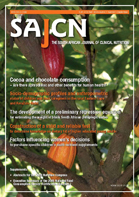Construction of a valid and reliable test to determine knowledge on dietary fat of higher-educated young adults
Abstract
Objective. The construction of a questionnaire, in the format of a test, to determine knowledge on dietary fat knowledge test that considered the psychometric issues raised about nutrition knowledge questionnairesof higher-educated young adults. Design. The fat topics on dietary fat included were in accordance with those tested previously. Forty multiple-choice items were drafted as questions and incomplete statements following the item construction rules. The items were reviewed by nutrition and food science professionals for content- and face-related evidence (n=4 respectively) and by students representing the study population for face-related evidence (n=16) of validity. Twenty items were removed as the panel questioned their relevance and replaced with 17 items reviewed by them. The items now largely focused on food sources of fat. These remaining37 items formed the preliminary testquestionnaire that was administered to two groups of higher-education students expected to differ in nutrition knowledge level. Item analysis was performed on the completed questionnaires. The completed and scored items were statistically analysed to determine which items could be retained for the test. Items meeting the item analysis criteria formed the test. The Mann-Whitney teststatistic was used to determine the construct-related evidence of validity and the Kuder-Richardson (K-R) 20 formula for the reliability of the test. Results. Twenty items were removed as the panel questioned their relevance and replaced with 17 items reviewed by them. The items now largely focused on fat food sources. The 37-item questionnairepreliminary test was completed by 99 and 87 students respectively forming the knowledgeable and less knowledgeable groups. Eighteen items remained after the statistical item analysis. Eight items did not meet the difficulty and discrimination index criteria respectively, 9 the item-to-total correlation criteria and 13 the variableanswer distribution criteria. The 18-item test was found to be reliable (K-R20 = 0.8997), as well as valid, since a significant difference (p < 0.001) in knowledge was found between the groups in the expected direction. Eighteen items remained after the item analysis and were ranked according to their difficulty indices in the test. Conclusion. The test can be used to compare the knowledge scores of groups and of individuals as it met the reliability coefficient of 0.75 and 0.85 respectively to make such score decisions.The 18-item test was found to be reliable (K-R20 = 0.8997), as well as valid, since a significant difference (p < 0.001) in knowledge was found between the groups in the expected direction.
Published
2008-06-12
How to Cite
Venter, I. (2008). Construction of a valid and reliable test to determine knowledge on dietary fat of higher-educated young adults. South African Journal of Clinical Nutrition, 21(3), 133-140. Retrieved from http://sajcn.redbricklibrary.com/index.php/SAJCN/article/view/211
Issue
Section
Original Research
Material submitted for publication in the South African Journal of Clinical Nutrition (SAJCN) is accepted provided it has not been published elsewhere. Copyright forms will be sent with acknowledgement of receipt and the SAJCN reserves copyright of the material published.
The SAJCN does not hold itself responsible for statements made by the authors.


